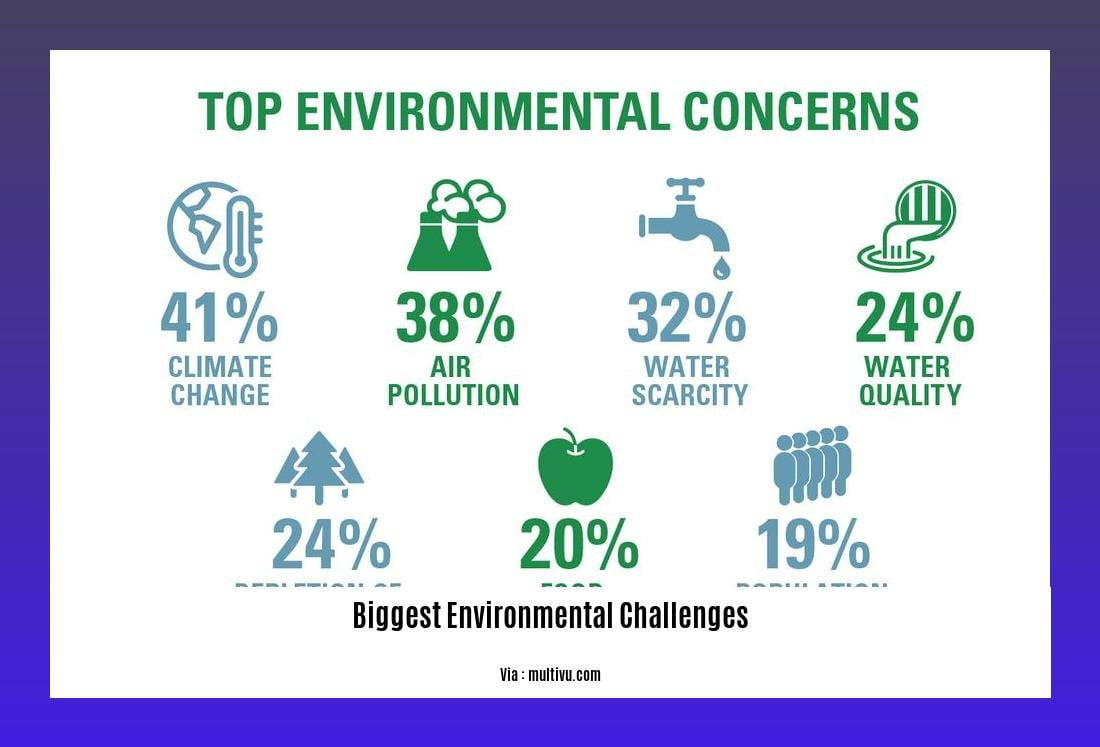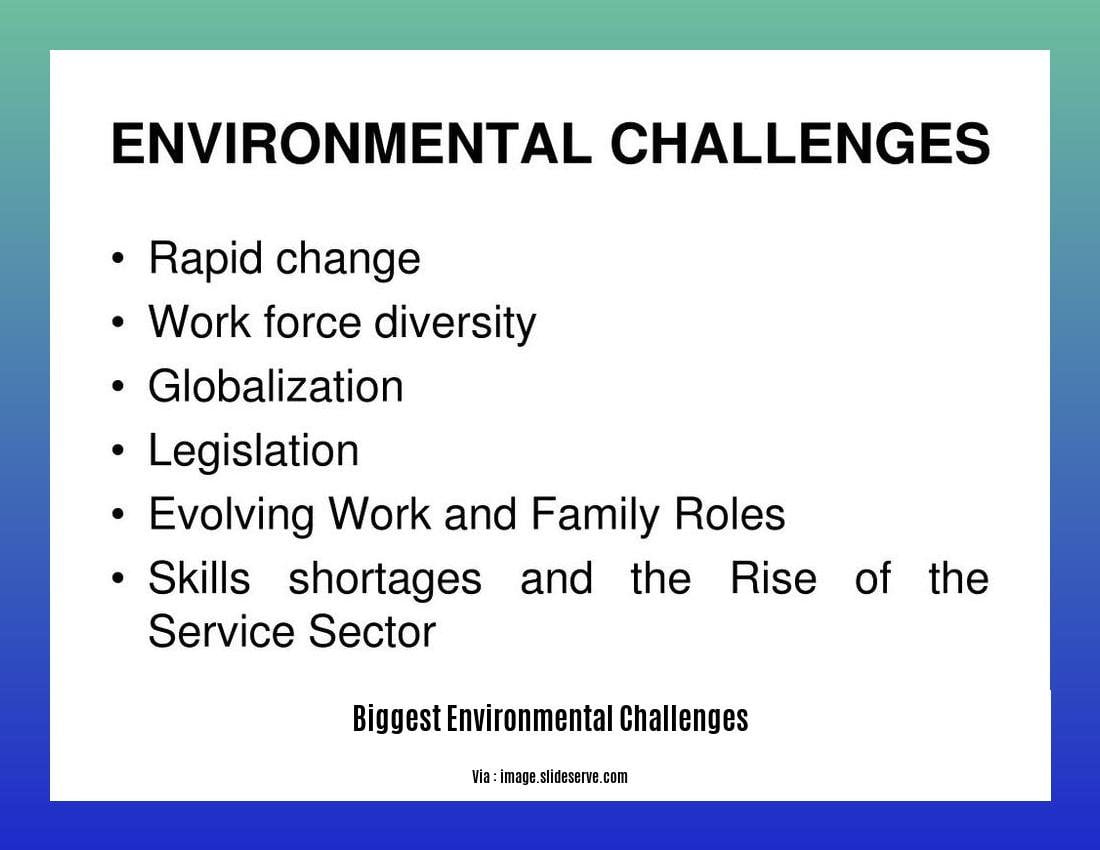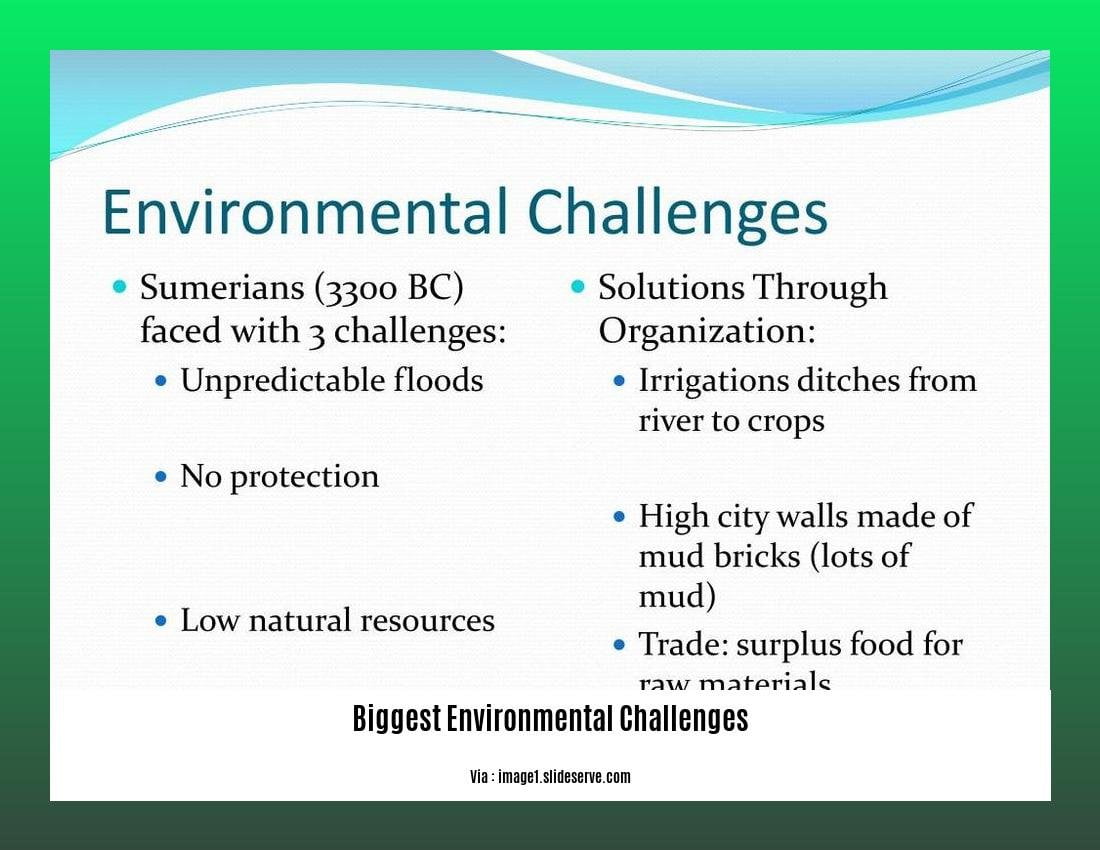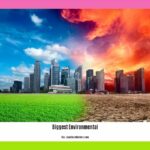The biggest environmental challenges that our planet faces today include climate change and global warming, deforestation, plastic pollution, and water scarcity and pollution. These issues pose significant threats to the delicate balance of our ecosystems and the well-being of both human and animal life. Understanding the causes and impacts of these challenges is crucial in order to effectively address and mitigate their consequences. In this article, we will delve into these pressing issues, exploring their far-reaching effects and potential solutions towards a more sustainable future.
Key Takeaways:
Climate change is one of the biggest environmental challenges we face today. It refers to the long-term shifts in temperature and weather patterns caused by greenhouse gas emissions. The impacts include rising global temperatures, sea level rise, extreme weather events, and negative effects on ecosystems and human health.
Deforestation is another significant environmental challenge. It involves the clearing, destruction, or removal of forests, primarily for agriculture, logging, or urbanization. Deforestation leads to habitat loss, carbon emissions, soil erosion, and disruption of the water cycle.
Pollution is a major environmental problem that affects air, water, and land. It is caused by various sources, such as industrial activities, transportation, and waste disposal. Pollution damages ecosystems, harms wildlife, and poses health risks to humans, such as respiratory diseases and exposure to toxins.
Biodiversity loss refers to the declining variety of species and ecosystems globally. It is driven by factors like habitat destruction, pollution, climate change, and invasive species. Biodiversity loss has severe consequences, including reduced ecosystem resilience, disruption of ecological networks, and the loss of valuable genetic resources.
These environmental challenges require urgent attention and action. Addressing climate change, deforestation, pollution, and biodiversity loss is crucial for preserving the planet’s natural resources, protecting vulnerable ecosystems, and ensuring the well-being of future generations. By raising awareness, implementing sustainable practices, and advocating for policy changes, we can work towards a more sustainable and resilient future.
Biggest Environmental Challenges

Climate Change
Climate change is one of the biggest environmental challenges we face today. Rising temperatures, changing weather patterns, and the increased frequency of extreme weather events are all evidence of this alarming phenomenon. Human activities, such as burning fossil fuels and deforestation, contribute to the release of greenhouse gases, trapping heat in the atmosphere and causing the Earth’s temperature to rise. This has far-reaching impacts on ecosystems, wildlife, and human populations around the globe.
Deforestation
The widespread destruction of forests poses a significant challenge to our environment. Deforestation not only leads to the loss of precious habitats for countless plant and animal species but also contributes to climate change. Trees play a crucial role in absorbing carbon dioxide and releasing oxygen, helping to regulate the Earth’s climate. Additionally, deforestation disrupts the water cycle, increases the risk of soil erosion, and threatens biodiversity.
Pollution
Pollution, in its various forms, is another major environmental challenge that demands immediate attention. The release of pollutants into the air, water, and soil has detrimental effects on both human health and ecosystems. Air pollution caused by vehicle emissions and industrial activities leads to respiratory problems and contributes to climate change. Water pollution from industrial waste and agricultural runoff contaminates water bodies, harming aquatic life and making water unfit for human consumption.
Biodiversity Loss
The loss of biodiversity is a critical environmental challenge that often goes unnoticed. Human activities such as habitat destruction, overexploitation, and pollution have resulted in the extinction of numerous species and the degradation of ecosystems. Biodiversity loss not only negatively impacts the natural world but also disrupts ecological balance and can have cascading effects throughout the food chain. Protecting and preserving biodiversity is essential for the overall health and sustainability of our planet.
By understanding these biggest environmental challenges, we can begin to address them effectively and work towards a more sustainable future. It is crucial to take collective action, from individual lifestyle choices to global policy changes, to mitigate climate change, halt deforestation, reduce pollution, and protect biodiversity. Only by working together can we ensure a healthier and more resilient planet for future generations.
| Environmental Challenge | Key Issues |
|---|---|
| Climate Change | Rising temperatures, extreme weather events |
| Deforestation | Habitat loss, carbon emissions, disrupted ecosystems |
| Pollution | Air pollution, water pollution, health impacts |
| Biodiversity Loss | Extinction, ecological imbalance, ecosystem degradation |
To learn about the biggest environmental issues, including the problems faced by the Philippines, check out our article on biggest environmental issues.
Discover the pressing environmental challenges in the world today by clicking on biggest environmental issues in the world.
Explore the specific environmental problems in the Philippines by reading about the biggest environmental issues in the Philippines.
If you’re interested in understanding the biggest environmental problems faced by the Philippines, you won’t want to miss our comprehensive guide on biggest environmental problems in the Philippines.
Please note that the above links are clickable and will direct you to the respective articles.
Plastic Pollution

Plastic pollution is a pressing environmental challenge that demands immediate attention. Its detrimental impact on ecosystems and human health cannot be ignored. As search results may fail at times, it is important to acknowledge the severity of this issue and take action towards finding solutions.
The Impact of Plastic Pollution
Plastic pollution is a global problem that affects both land and marine environments. The staggering amount of plastic waste entering our oceans annually, estimated at 8 million metric tons according to a report by the United Nations Environment Programme, poses a grave threat to marine life. The entanglement and ingestion of plastic by various species lead to injury and death, disrupting the delicate balance of marine ecosystems.
But plastic pollution does not limit its harmful effects to the oceans alone. Landfills overflowing with plastic waste contribute to soil degradation and water contamination. The production and improper disposal of plastic also contribute to greenhouse gas emissions, exacerbating climate change.
Taking Action Against Plastic Pollution
Thankfully, efforts to combat plastic pollution have gained momentum in recent years. Governments, organizations, and individuals around the world are taking steps towards finding solutions to this environmental challenge.
For example, the European Union has implemented measures to ban or limit single-use plastics, aiming to reduce plastic waste generation. Similar initiatives have been rolled out in several countries globally, reflecting the growing acknowledgment of the need for change.
Valuable Resources to Combat Plastic Pollution
To better understand the problem of plastic pollution and explore potential solutions, there are valuable resources available. The Plastic Pollution Coalition, an organization dedicated to advocating for a plastic-free planet and promoting sustainable alternatives, offers a wealth of information and resources on their website.
You can visit their website at Plastic Pollution Coalition to learn more about the issue and find resources that can empower individuals and communities to take action against plastic pollution.
Another reputable source for information on plastic pollution is National Geographic. Their comprehensive coverage of environmental issues includes in-depth articles, captivating photographs, and engaging videos that highlight the impacts of plastic pollution and offer potential solutions. To explore their extensive collection of resources, visit National Geographic – Plastic Pollution.
Key Takeaways:
- Plastic pollution poses a significant threat to both land and marine environments.
- Annual estimates suggest that 8 million metric tons of plastic enter our oceans each year.
- Marine life is endangered by the entanglement and ingestion of plastic waste.
- Landfills overflowing with plastic waste contribute to soil degradation and water contamination.
- Plastic production and improper disposal contribute to greenhouse gas emissions and climate change.
- Governments and organizations are implementing measures to reduce plastic waste generation.
- The Plastic Pollution Coalition and National Geographic offer valuable information and resources to combat plastic pollution.
Citations:
– Plastic Pollution Coalition. Retrieved from plasticpollutioncoalition.org
– National Geographic – Plastic Pollution. Retrieved from nationalgeographic.com
Water Scarcity and Pollution
Water scarcity and pollution are two pressing environmental challenges that have wide-ranging impacts on ecosystems and human populations. In this article, we will explore the causes and consequences of these problems, as well as potential solutions to mitigate their effects.
Understanding Water Scarcity
Water scarcity refers to the imbalance between the demand and availability of freshwater resources. As our global population continues to grow, increasing urbanization and industrialization place a greater strain on water supplies. Factors such as climate change, inefficient water management practices, and pollution exacerbate the problem.
Water scarcity is a complex issue that has far-reaching consequences. It affects not only the availability of drinking water for individuals but also agricultural productivity, food security, and ecosystem health. In many regions, inadequate access to safe and clean water leads to waterborne diseases and compromised sanitation, posing risks to human health.
Causes and Consequences of Water Pollution
Water pollution occurs when harmful substances contaminate freshwater sources, making them unsuitable for human consumption and damaging aquatic ecosystems. Various activities contribute to water pollution, including industrial discharge, agricultural runoff, improper waste disposal, and sewage leakage.
The consequences of water pollution are severe. Contaminated water can cause immediate harm to humans through the ingestion of toxins, leading to illnesses and even death. Aquatic ecosystems suffer as well, with pollutants disrupting the delicate balance of marine life, harming fish, plants, and other organisms.
Solutions to Address Water Scarcity and Pollution
Addressing water scarcity and pollution requires a multidimensional approach that combines individual actions, government regulations, and innovative technologies. Here are some potential solutions to consider:
Conservation and Efficient Water Use: Adopting water-efficient practices in agriculture and promoting conservation measures at home and in industries can help reduce water wastage and increase water availability.
Water Treatment and Infrastructure: Investing in water treatment facilities and improving infrastructure can help improve water quality and ensure access to safe drinking water for all.
Water Management Policies: Governments should implement comprehensive water management policies that prioritize sustainable use, protect water resources, and mitigate pollution.
Community Engagement and Awareness: Promoting education and awareness about water scarcity and pollution can empower individuals to make informed choices and support sustainable water practices.
Technological Innovations: Developing and implementing new technologies, such as water filtration systems and desalination methods, can help expand access to clean water and mitigate pollution.
Key Takeaways:
- Water scarcity and pollution are significant environmental challenges that affect ecosystems and human populations.
- Water scarcity refers to the imbalance between the demand and availability of freshwater resources.
- Water pollution occurs when harmful substances contaminate freshwater sources, endangering human health and aquatic ecosystems.
- Adequate water management, conservation measures, and technological innovations are essential for addressing these challenges.
- Government regulations, community engagement, and awareness play a crucial role in mitigating water scarcity and pollution.
Sources:
FAQ
Q1: What is climate change and how does it impact the environment?
A1: Climate change refers to long-term shifts in temperature patterns and weather conditions caused by human activities, primarily the emission of greenhouse gases. It leads to rising global temperatures, melting ice caps, increased frequency and intensity of extreme weather events, and disruption of ecosystems. These changes have severe consequences for biodiversity, agriculture, water resources, and human health.
Q2: What are the main causes of deforestation and why is it concerning?
A2: Deforestation is primarily caused by human activities such as agriculture, logging, and urbanization. It is concerning because it results in the permanent removal of forests, leading to habitat loss, biodiversity decline, soil erosion, and carbon dioxide emissions. Deforestation also disrupts the water cycle, affects climate patterns, and contributes to global warming.
Q3: How does plastic pollution affect marine ecosystems?
A3: Plastic pollution poses a significant threat to marine ecosystems. When plastic waste enters the ocean, it can entangle marine animals, causing injuries and impairing their ability to swim and hunt. Many marine species, including turtles, birds, and fish, mistake plastic pieces for food and ingest them, leading to internal injuries, starvation, and death. Additionally, plastic debris can disrupt the balance of marine ecosystems by introducing harmful chemicals and altering food chains.
Q4: What are the consequences of water scarcity and pollution?
A4: Water scarcity and pollution have far-reaching consequences. Water scarcity refers to the lack of sufficient freshwater resources to meet the needs of communities and ecosystems. It can lead to inadequate sanitation, compromised hygiene, and limited agricultural productivity. Water pollution, on the other hand, occurs when contaminants, such as chemicals, pathogens, and plastics, enter freshwater sources. It can harm aquatic life, contaminate drinking water supplies, and negatively impact human health, causing diseases and even death.
Q5: How does biodiversity loss affect ecosystems and human well-being?
A5: Biodiversity loss refers to the decline in the variety and abundance of species in a particular habitat or globally. It has profound effects on ecosystems and human well-being. Biodiversity loss disrupts ecological balance, weakens the resilience of ecosystems, and reduces their ability to provide essential services such as pollination, water purification, and climate regulation. It also reduces the availability of resources like food, medicines, and raw materials, and can increase the risk of zoonotic diseases.
- Guatemala vs. Costa Rica: Plan Your Trip Smartly - April 16, 2025
- Master Types of Pumps: Ultimate Guide to Selection - April 16, 2025
- Unlock Types of Makeup Secrets: Master Any Look Now - April 16, 2025
















